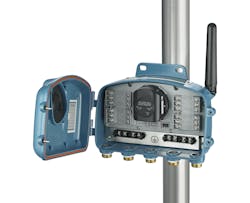Safer and more efficient operations require access to more asset data than ever before, but it is often not economically feasible to connect these assets using wired networks. A leading technology for addressing this issue is a wireless sensor network, such as WirelessHART, and IEC 62591 standard.
In the past, only instruments and other equipment with WirelessHART native connectivity, or with a WirelessHART THUM adapter installed, were able to connect with a WirelessHART network. But now, with the recent introduction of Emerson Rosemount 702 and 802 WirelessHART remote I/O devices, many other types of equipment can be controlled and monitored from control rooms and other locations.
Typical legacy installations often have remote and widely dispersed, or in some cases standalone, assets. Examples include tank farms, valve stations, safety shelters and many others. Unfortunately, these installations often have no spare wires running to a control room or other central monitoring point, and the cost of installing new wiring is often prohibitive. WirelessHART remote I/O devices address this issue in a simple and cost-effective manner.
Distributed discrete signal monitoring and control
Connecting to assets, regardless of location, is driving the increasing demand for remote I/O, including high density discrete I/O points. To date, most of this access has been provided by wired remote I/O devices, but there is now a wireless alternative.
Many of these assets have access to electric power for actuating or driving the device itself, but providing wired control infrastructure to all these points is often uneconomic. This is particularly true when the total cost of new signal wiring — and the associated conduit and fittings, cable trays, trenching and junction boxes — is considered.
Typical assets requiring remote monitoring include:
- Motor operated valve (MOV) control and position monitoring
- Manual open/close or on/off valve monitoring and control
- Pump monitoring and control.
These applications, and many more, each have a significant number of discrete status signals and control points associated with them, which combined with their locations, is driving the demand for wireless discrete control and monitoring.
High density flexible discrete I/O
Emerson Rosemount 702 WirelessHART remote I/O device has two discrete DI/DO channels, which is sufficient for many applications. But when the need arises for more I/O, a better solution is Emerson Rosemount 802 WirelessHART remote I/O devices with eight discrete DI/DO channels (Figure 2). In many applications, the 802 can replace multiple 702s, reducing the number of WirelessHART network messages and traffic.
Eight fully configurable discrete I/O channels can be arranged as all discrete input, all discrete output, or any combination thereof on any channel at any time, providing the flexibility needed for many high I/O density applications. Furthermore, any discrete channel can be inverted to provide the opposite effect. For inputs, this means that a normally-open switch can be used to replace a normally-closed switch. For outputs, if a true state should cause a device to be turned off, the transmitter can be configured to the opposite, in either case to match the required state of the connected field device.
For monitoring discrete inputs, the WirelessHART remote I/O device connects to dry contact SPST switches and can detect any momentary state change greater than 10 milliseconds. Each input can also count and store the number open/closed cycles, which is very useful for identifying chatter and managing nuisance alarms. A latching feature can be configured to detect either rising or falling input state changes.
For control via the discrete outputs, the transmitter can send a control signal up to 28VDC/100mA maximum. For those instances where greater current or voltage is required, an interposing relay and power supply can be used. The latch period (hold time) can be configured in one-second increments anywhere between zero seconds to 10 minutes. Each I/O channel has three terminals for power out, input or output, and common.
The WirelessHART remote I/O device and its I/O terminals can be externally energized by 10-30VDC line power. Alternatively, it can be energized by an Emerson SmartPower Module with an up to seven-year battery life at one-minute update rates, beneficial for applications where external line power is not available.
External 10-30VDC line power alleviates the need for module replacement, and it is beneficial for applications requiring very frequent update rates. Field equipment often has localized power that can be used for this purpose, and any required interposing relays can be used if needed to switch greater voltages and currents.
When the WirelessHART remote I/O device is externally powered via 10-30VDC, the PWR OUT terminal outputs constant voltage at two VDC less than the voltage powering the transmitter. For example, if 30VDC is used to power the device, the PWR OUT terminal will continuously output 28VDC.
The WirelessHART remote I/O device supports the most common area classifications of NEC Class 1 Div 2 Nonincendive and IEC Zone 2 Intrinsically Safe over its full operating temperature range of -40 to 85°C (-40 to 185°F).
The following are some applications where WirelessHART remote I/O devices can be used to provide an array of benefits.
Field-proven results
Pump station monitoring and control
Lack of awareness of isolation valve position and the pump motor run indication negatively impacts safety and efficiency (Figure 3). Awareness of isolation valve proximity switch status before entering a work area improves personnel safety, particularly in hazardous and/or remote areas. Integrating confirmation of motor status into control logic provides the ability to prevent the pump from starting without each valve in the proper position.
Depending on the arrangement of the pumps and isolation valves, a single WirelessHART remote I/O device could potentially be used on multiple assets, such as two pumps, or a pump and an MOV.
MOV monitoring and control
MOVs are typically not actuated frequently, and they are often used to isolate processes or facilities (Figure 4). A single Rosemount 802 WirelessHART remote I/O device can remotely control an MOV by providing open/closed/stop commands, and alarm contacts from the MOV can be monitored via proximity switches to indicate if the valve is open/closed/or in transition.
Like the pump station scenario, the key areas of concern are protecting people and process optimization.
Isolation valve monitoring
Because of the expense of installing actuators, such as MOVs, many critical isolation valves are manually operated (Figure 5). However, being able to confirm the status of each valve does not need to be prohibitively costly since a single WirelessHART remote I/O device and a pair of proximity sensors can monitor up to four valves to confirm if they are in the open or closed position.
This eliminates the need for manual rounds to confirm valve position, while providing the ability to count the number of times the valves have been cycled. This information can be used to justify the addition of an actuator, and/or as input to an asset management system to schedule maintenance, thus improving asset life and safety.
Rotating equipment monitoring
Machine guards or covers are required on rotating equipment to protect workers from accessing the machinery while it is operating (Figure 6). A WirelessHART remote I/O device can be installed to protect workers by monitoring proximity sensors connected to the machine guards to ensure they are closed when workers are present.
The status of the cover can also be linked to the work permit so that it cannot be issued without confirming the cover is in place and the machine is off/isolated, and the permit cannot be closed as complete until the cover is back in position. The control system can also have logic that prevents equipment operation while the cover is removed.
Equipment and personnel safety monitoring
Safety showers and eyewash stations are distributed throughout facilities to protect workers (Figure 7). These stations often include a switch to notify the control room and/or emergency responders when the station is activated so that they can respond quickly to support the person whose safety has been compromised. Safety shower and eyewash stations can also have door, temperature, flow, and/or pressure switches. A WirelessHART remote I/O device can monitor all these switches to verify actuation, along with the condition of the station.
Conclusion
All these examples reinforce the importance of worker safety and the protection of assets, along with the important role of reliable data provided remotely to support those goals. Historically, being able to monitor the status of widely distributed assets was often not feasible with wired devices, but advances in technology have overcome these limitations. Monitoring and responding to any signal from anywhere provides a better understanding of processes and asset status, while also supporting a safer working environment.
Ryan Lindsey is a global product manager at Emerson, supporting the Pervasive Sensing product line. With over 15 years of experience supporting measurement and analytical instrumentation, he is an innovator and strategic leader for industrial wireless technology. He holds a bachelor’s degree in mechanical engineering from Minnesota State University, Mankato.
About the Author
Ryan Lindsey
Global product manager at Emerson
Ryan Lindsey is a global product manager at Emerson, supporting the Pervasive Sensing product line. With over 15 years of experience supporting measurement and analytical instrumentation, he is an innovator and strategic leader for industrial wireless technology. He holds a bachelor’s degree in mechanical engineering from Minnesota State University, Mankato.






